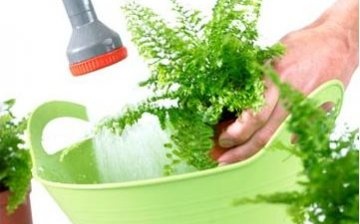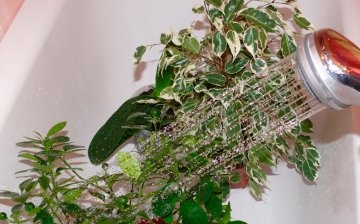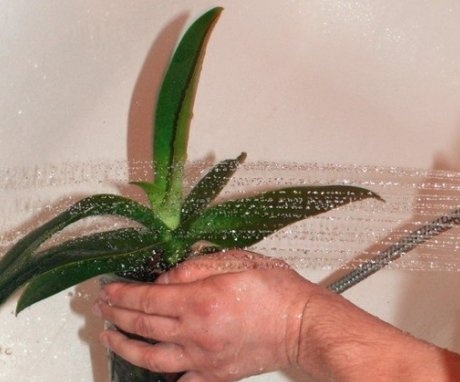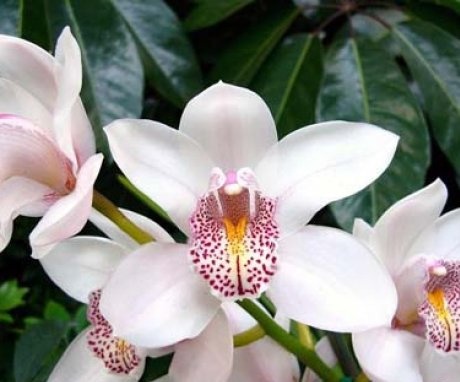Hot shower for indoor plants - procedure, benefits and harms
To appreciate the benefits of a hot shower for indoor plants, it is enough to remember your feelings during this procedure. The body relaxes, the pores open, the skin breathes. The leaves of plants also have pores through which respiration occurs. Moreover, for plants this is the only way of breathing. When the pores are clogged flower starts to hurt. To avoid this, it is useful to arrange a bath day for the plants. Moreover, the shower is much more effective than ordinary wiping, it cleans the leaves and the stem.
Content:
- The benefits and harms of the procedure
- How to carry out the procedure correctly?
- Plants for which hot showers are good for
The benefits and harms of the procedure
A hot indoor plant shower has the following benefits:
- The procedure allows you to stop drying out and falling of leaves.
- Eliminates all sorts of pests and parasites. If we are talking about spider mites, before showering, you need to wipe the leaves with a damp sponge and foam from dishwashing detergent.
- If you want to speed up leaf growth or flowering, a hot shower is great.
- Even a healthy plant can benefit from this procedure. It works like a kind of shake-up.
- If the tips of the leaves begin to dry out, and the leaves themselves turn yellow, a hot shower will help solve this problem too.
- A plant that has recovered and needs rehabilitation will take a shower well.
Harm can only be done if the rules are not followed. To water plants with boiling water and you can't do it too often. There will be no benefit, and the plant may die.
Do not carry out this procedure in the winter or do it rarely, only if it is heavily soiled.
In winter, the plants do not need shaking. Most of them are dormant at this time of the year, growth slows down, the flower accumulates strength. A hot shower can awaken it and trigger growth.
How to carry out the procedure correctly?
It would seem that what could be easier - to wash flower in the shower. But this procedure has its own rules, which are recommended to be followed so as not to damage the plant. And do not forget that despite the benefits, this often cannot be done.
Some gardeners recommend washing plants this way once a month, others once every two months. Sometimes after the first procedure, the effect may not be. Do not despair, after several times the plant will surely respond with gratitude to your concern.
Never wash a dry flower. It needs to be watered and given time to soak in water (about 30 minutes) - otherwise it will simply cook.
How to carry out the procedure:
- Put the watered flower in the bath. Tilt the pot slightly with one hand, and use a sliding motion to water the flower with the other.
- The water should not be too hot. The temperature is about 50 degrees. It is not necessary to measure the temperature. Put your hand up. If the hand recognizes the water as hot, but tolerates, the temperature is sufficient.
- There is no need to hold the shower from above, directing the jet towards the plant The water should slide. The plant should be under water for no more than 30 seconds.
- You can wash everything: pot, earth, leaves, stems. But too much water should not get into the soil, so the pot must be tilted.
- If you are afraid to overflow, wrap the pot of dirt with plastic wrap.
- After washing, do not place the plant on a cold windowsill. It is better to leave it in the bathroom overnight, and do not open the door in order to prevent temperature changes and maintain high humidity.
- After the shower, you can put the plants in their new place. After the procedure, it will tolerate the move well.
Plants for which hot showers are good for
A hot shower has its own contraindications. So, for example, this procedure cannot be carried out with flowering plants. Delicate flowers may not survive this. If your flower has already bloomed, it is better to spray the leaves from a spray bottle with hot water, being careful not to touch the buds.
The plant must already be rooted for a hot shower to be beneficial, not harmful. That is, if you have just transplanted it, refrain from carrying out the procedure for a while.
Plants with downy leaves such as begonia, geranium, gloxinia. It is generally better not to wet them with water, they do not like excess moisture.
Let's list the plants that will gratefully accept a hot shower.
What indoor flowers "like" a hot shower:
- Gardenia. This is a rather moody flower. A hot shower will do her good if you don't use it too often and keep the delicate buds out of the water. This flower does not like heat at all, try not to overdo it with the water temperature.
- Orchid... Hot showers are often used to revive an orchid. Experienced gardeners recommend not exceeding the water temperature of 45 degrees. A shower will help if you want to achieve re-flowering. Do not water the plant from the shower if it shows signs of rot.
- Spathiphyllum... An unpretentious plant, a hot shower loves and tolerates well. If the flower starts to turn yellow, then the place is too sunny. Rinse it in the shower, and after the procedure, put it in a new place.
- Dracaena... Dracaena tend to have dried, yellow leaf tips. Sometimes spraying is not enough, then you can resort to a hot shower procedure. They love humidity, try to leave them in the bathroom after a shower, where the air is humid enough.
A hot shower is an opportunity to improve the condition of plants and give them a great look. If done correctly, it will bring significant benefits.
More information can be found in the video.













